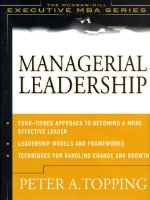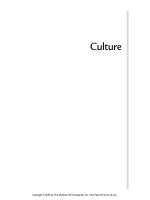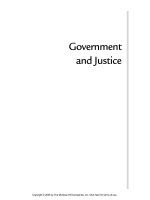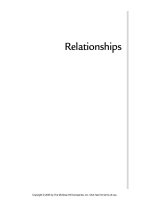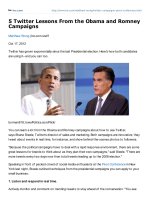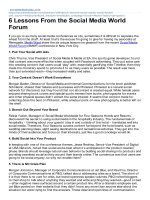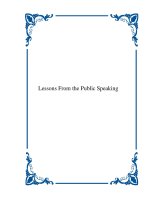Mcgraw hill team bush leadership lessons from the bush white house ebook
Bạn đang xem bản rút gọn của tài liệu. Xem và tải ngay bản đầy đủ của tài liệu tại đây (849.74 KB, 194 trang )
Table of Contents
BackCover
Team Bush - Leadership Lessons from the Bush White House
Birth of a Commander-in-Chief
Part I: Building the Bush Team
Chapter 1: The Making of an MBA President
Making the MBA Man
" Sky Decker " at Capitalism's West Point
The " Teamwork " MBA
Arbusto to the White House
Chapter 2: The Bush Leadership Style
Don't Start Without a Business Plan
Make the Bureaucracy Fit Your Personality
Establish Rules Early and Stick to Them
Develop Your Own Leadership Style
An Unusual Job
Bush's Style
Bush Lessons
Chapter 3: The Teamwork Imperative
Get Unfiltered Information
Building Team Bush
Nurture Talent and Get the Best from Them
Bush Lessons
Part II: Leading the Bush Way
Chapter 4: Bush as Strategist
Prepare Early: The First Steps Are Crucial
Team Bush's Rules for Winning
Develop a Playbook . . . and Execute It
Respond to Crises, but Stick to the Plan
Debate, Decide - and End the Debate
You're Only as Good as Your Last Victory
Bush Lessons
Chapter 5: The Importance of Message
Manage the Media
Package the Story, Feed the Zoo
Have a Story - and Stick to It
Find Your Own Voice When Steering Through Crises
Get Back on Message (Even If Events Pull You Off)
Listen to the Polls, But Don't Be Ruled by Them
Link Message with Discipline
Bush Lessons
Chapter 6: The Disciplined Chief Executive
Exercise to Build Discipline
On Time, All the Time
Calibrate the " Loyalty Thermometer "
Build on Pragmatism, Not Ideology
Plugging Leaks
Work Hard But Take Breaks (and Then Still Work Hard)
Bush Lessons
Chapter 7: Leveraging Assets
Focus Your Power to Enhance Your Strength
Don't Take Allies for Granted
" It's About Control "
Act Quickly, But Leave No Fingerprints
Use Innovative Tactics to Maintain a Cohesive Team
Focus on Results
Outflank Critics - Quickly
Shifting the Balance of Power
Bush Lessons
Part III: Teaming Up For the Future
Chapter 8: Avoiding the Seven Deadly Leadership Traps
1. Painting Everyone with the Same Brush
2. Imposing Rigid Discipline that Stifles Deliberation and Debate
3. Allowing the Team to Unravel
4. Making Black-and-White Decisions in a Shades-of-Gray World
5. Losing Control of the Agenda
6. Driving Away Those Who Don't Share Your Vision
7. Losing Support of Important Outside Constituencies
Bush Lessons
Chapter 9: Winning the Expectations Game
Playing the Expectations Game
Build Capital to Spend It
Build Narrow Support Into a Broad Base
Use the Broad Base to Champion Policy
EXAMPLE: The Bush Doctrine
EXAMPLE: Economic Strategy
Pluck and Luck: A Winning Combination
Bush Lessons
The Strength of a Leader
Sources and Notes
Birth of a Commander in Chief
Chapter 1
Chapter 2
Chapter 3
Chapter 4
Chapter 5
Chapter 6
Chapter 7
Chapter 8
Chapter 9
The Strength of a Leader
Index
Index_B
Index_C
Index_D
Index_E
Index_F
Index_G
Index_H
Index_I
Index_J
Index_K
Index_L
Index_M
Index_N
Index_O
Index_P
Index_R
Index_S
Index_T
Index_U
Index_V-W
Index_Y
Team Bush: Leadership
Lessons from the Bush
White House
by Donald F.
Kettl
ISBN:0071416331
McGraw-Hill © 2003 (220 pages)
This text is a portrait of the
successes and occasional
setbacks of George W. Bush
in his first 2 years as U.S.
President; it is also an
examination of a leadership
style based on team
performance and knowledge.
Table of Contents
Team Bush—Leadership Lessons from
the Bush White House
Birth of a Commander-in-Chief
Part I - Building the Bush Team
Chapter 1 -
The Making of an MBA
President
Chapter 2 - The Bush Leadership Style
Chapter 3 - The Teamwork Imperative
Part II - Leading the Bush Way
Chapter 4 - Bush as Strategist
Chapter 5 -
The Importance of
Message
Chapter 6 -
The Disciplined Chief
Executive
Chapter 7 - Leveraging Assets
Part III - Teaming Up For the Future
Chapter 8 -
Avoiding the Seven Deadly
Leadership Traps
Chapter 9 - Winning the Expectations
Game
The Strength of a Leader
Sources and Notes
Index
Back Cover
Team Bush is a gripping portrait of George W. Bush at the helm,
one that transcends politics to provide an inside look at the hands-
on specifics of Bush’s aggressive yet pragmatic leadership style.
This fast-paced yet powerful book explains how the Bush model can
be used by any executive to streamline management and decision
processes—and establishes a new standard for results-oriented
leadership in the 21st century.
About the Author
Donald F. Kettl, Ph.D., is a professor of political science and public
affairs at the Robert M. L Follette School of Public Affairs at the
University of Wisconsin-Madison. The executive director of The
Century Foundation of Project on Federalism and Homeland
Security, Dr. Kettl is also a nonresident senior fellow in
governmental studies at the Brookings Institution and former
director of the institution’s Center for Public Management. He has
written, cowritten, or edited over a dozen books, including Deficit
Politics and The Transformation of Governance.
Team Bush—Leadership Lessons from the Bush White
House
Donald F. Kettl
McGraw-Hill
Copyright © 2003 by The McGraw-Hill Companies, Inc. All rights reserved. Printed in the
United States of America. Except as permitted under the United States Copyright Act of
1976, no part of this publication may be reproduced or distributed in any form or by any
means, or stored in a data base or retrieval system, without the prior written permission of
the publisher.
1 2 3 4 5 6 7 8 9 0 DOC/DOC 0 9 8 7 6 5 4 3
ISBN 0-07-141633-1
First edition
McGraw-Hill books are available at special quantity discounts to use as premiums and sales
promotions, or for use in corporate training programs. For more information, please write to
the Director of Special Sales, Professional Publishing, McGraw-Hill, Two Penn Plaza, New
York, NY 10121-2298. Or contact your local bookstore.
This book is printed on recycled, acid-free paper containing a minimum of 50% recycled,
de-inked fiber.
Team Bush is not authorized, endorsed by, or affiliated with President George W. Bush.
Library of Congress Cataloging-in-Publication Data
Kettl, Donald F.
Team Bush : leadership lessons from the Bush White House / by Donald F. Kettl.
p. cm.
ISBN 0-07-141633-1 (alk. paper)
1. Leadership. 2. Political leadership. 3. Bush, George W. (George
Walker), 1946- 4. United States—Politics and government—2001– I. Title.
HD57.7.K49 2003
303.3'4'092—dc21
2003000691
Acknowledgments
This book had its genesis in a series of conversations with Jeffrey Krames at McGraw-Hill.
He raised the key questions: What is George W. Bush’s style? How does it differ from the
styles that other presidents have developed? Does it seem to work—for him and, just as
importantly, for the country? The questions launched me down the winding road that ended
in this book. I’m grateful indeed for his provocative suggestions and constant insights along
the way.
The book benefited enormously from conversations and interviews with a great many
people, including both Washington insiders and experts who have long followed presidential
politics. I’m especially indebted to extended conversations with Charles O. Jones (University
of Wisconsin-Madison), Thomas Mann (Brookings Institution), William Eggers (Deloitte
Research and manager of the Texas Performance Review during Bush’s governorship), and
Vance McMahon (Bush’s gubernatorial policy adviser). In addition, I interviewed a number
of experts who spoke on background and requested anonymity. They immeasurably
enriched the book.
Zachary Oberfield proved an untiring and unfailingly helpful researcher. He dug out
important nuggets for the book—and he always proved a valued colleague in talking through
the issues raised by Bush’s management style. He is a true professional in every respect.
McGraw-Hill’s production staff was every author’s dream. I’m especially indebted to Tom
Lau, who designed the book’s cover. He perfectly captured not only the Bush style but also
the new blue-and-gold look that Bush brought to the Oval Office. Editing supervisor Scott
Kurtz and production supervisor Maureen Harper flawlessly and painlessly managed the
book’s production. Likewise, Patty Wallenburg’s typesetting was also exemplary and
incredibly swift.
I owe the greatest debts to my parents—who taught me first and best about what
teamwork really means—and to my wife, Sue. She not only provided unflagging support
through the writing but also remarkably keen insight into how best to frame the book’s
themes. She is the best teammate an author (or husband) could ever have.
Donald F. Kettl
Birth of a Commander-in-Chief
“This stuff about transformed? From my perspective, he is the same President Bush
that I saw going through different issues in Texas. He’s always been decisive, he’s
always been disciplined, he’s always been really focused, he’s always been a really
good delegator.”
—Karen Hughes, on the change in President Bush after September 11
Throughout his career as a political executive, George W. Bush has consistently exceeded
expectations. Doing it once or twice might be lucky. Doing it over and over has to require
real skill.
What’s the secret? Bush has carefully honed a style, based on building an effective team, to
make strong decisions. He doesn’t try to master the complexities of decisions. Rather, he
builds a team, he makes them master the complexities, he has them frame the issues—and
then he decides, firmly and without second thoughts. He’s ridden this style, over and over,
to successes that have amazed his friends and stunned his foes.
Consider a quick scorecard. Few analysts gave him a chance of unseating Texas Governor
Ann Richards in 1994, yet he beat her in the race. Political handicappers gave him slim odds
for a successful gubernatorial term, but he rolled to a huge victory in 1998. He explored a
presidential run, but cynics suggested he wasn’t nearly smart enough to be the nation’s
chief executive. When he won the nomination, Democrats relished the idea of Al Gore taking
him on.
One Republican insider, in fact, quietly whispered that watching Bush debate was like
watching his 12-month-old daughter try to walk, “never knowing when she might fall on her
face.”
Bush astounded everyone by holding his own against the vice president. He rode his debate
performance to a razor-thin presidential victory. When he got to Washington, insiders
discounted the chance that he could accomplish anything. Most Americans doubted that
Bush and congressional Democrats could put politics aside to work together. But he
cobbled together enough votes to pass a big, 10-year tax cut.
Even his friends were worried about how ready he’d be to make foreign policy decisions.
During the campaign, BBC News asked bluntly, “Can nice guy George Junior shed his
image as a political lightweight and demonstrate that he’s made of steel? Has he got what it
takes for one of the most powerful jobs in the world?”
But in the aftermath of the September 11 terrorist attacks, Bush rallied the country. When
he threatened the Taliban in Afghanistan, skeptics pointed to the Russians’ devastating
defeat in their own war with that country. Analysts warned that Bush’s plan might draw the
United States into another Vietnam. Bush attacked anyway. Within weeks the Taliban
crumbled. Bush’s approval rating soared to the highest level ever recorded.
Democrats reassured themselves with the fact that the president’s party almost always
loses seats in the midterm congressional elections. They thought they could keep control of
the Senate and dreamed of retaking the House. Bush launched a whirlwind last-week salvo
of campaigning. Republicans not only retained control of the House in 2002 but retook the
Senate. Bush yet again exceeded expectations. In the process, he solidified his position. He
worked to capitalize on his strength by launching an economic stimulus plan, seeking to
disarm Saddam Hussein, and countering North Korea’s threats to destabilize Asia.
In the aftermath of the September 11 attacks, the clear consensus was that the world had
fundamentally changed. In a stirring editorial, the New York Times said, “It was, in fact, one
of those moments in which history splits, and we define the world as ‘before’ and ‘after.’”
The sudden, awesome impact of the terrorists’ attacks fundamentally transformed
everything about the country and its role in the world.
If the world had changed, the striking thing is that Bush had not. He was the same man,
with the same style, as he had been as Texas governor. He had a strong sense of
confidence, a vision of what ought to be done, and a determination to do the job right. He
focused on the big picture with a decide-and-delegate style torn from the pages of MBA
casebooks. He didn’t devise a new style to deal with the unimaginable catastrophe. He put
to work the style he had developed throughout his life and had honed as Texas governor.
People have always underestimated him. In fact, some handicappers have rated him the
fourth best politician in his family (after his father, mother, and brother Jeb). None have ever
given him good odds for success. Yet time after time, he has exceeded expectations. He
has proven himself a surprisingly effective executive—a “reformer with results,” as he
promised during his 2000 presidential campaign. His easygoing outward manner masks a
tough, decisive executive who has consistently performed far better as a political leader
than almost anyone had imagined.
Just as important, he has lured opponents and skeptics into underestimating him. Some of
that comes from the image of the amiable dunce he has never been able to shake. Some of
it comes from the fact that his core skills aren’t analytical. Rather, they come from his finely
tuned skill of building a team and then using that team to make decisions.
Bush has a style that works for him and that fits his approach to management. As Vance
McMahan, former policy director for Bush in Austin, remarked, “It’s often said he’s a man
comfortable in his own skin—and I think that’s exactly right.”
Bush has a core set of ideas about what makes a good manager. He knows himself, he
knows what works for him, and he uses that style to guide his decisions with laserlike
precision.
Lawrence B. Lindsey, who had served in both the Reagan and first Bush administrations
before becoming a governor of the Federal Reserve Board and a Bush economic adviser,
told a reporter during the 2000 campaign, “The thing that struck me most about Bush early
on was how thoroughly comfortable with himself he was.”
Lindsey had brought together economists to advise the campaign. He found, “He’s really a
CEO. He asks us for our advice and we give it. Of course, if you have six economists, you
get seven opinions. Then he calls the shots.”
Lindsey also discovered that Bush wasn’t shy about rejecting advice he didn’t find helpful.
“He’s very much a Texan,” he explained, “and I was once on the receiving end of a very
straight-shooting response that one would not want to see printed.”
Historians will undoubtedly take generations to decide on his legacy. Policy wonks will battle
over whether he’s made right or wrong decisions. Friends will praise him for his leadership,
and foes will criticize him for his mistakes. However, it’s impossible to escape the central
fact: Bush has a distinctive management style that shapes his decisions and, indeed, his
presidency. It’s as clear and powerful a style as any president has brought to the Oval
Office. Thus, to understand Bush, it’s essential first to understand his style. And even to
begin charting his legacy will require starting first with the way he approaches the job.
Bill Clinton used to complain quietly that he was destined never to be a great president
because history never dealt him great problems. From his first days, Bush certainly never
had that worry—history dealt him great problems, in spades. Bill Clinton also used to talk
about building a bridge to the 21st century. He argued that the Reagan-Bush years marked
not only the end of the 20th century, but also the end of a generation of public policy.
Clinton hoped to define the new policies that would shape America for the next generation,
but the failure of his health-care plan, his battle with Newt Gingrich and the congressional
Republicans, his extramarital affair, and his impeachment by Congress made that
impossible.
History, in fact, might conclude that Clinton was a bridge to the 21st century—but that the
presidency of George W. Bush was on the other side. Whether that is history’s judgment—
or whether Bush, like Clinton, ends up as another transitional figure en route to yet another
new reality—depends on how Bush uses his style to shape the nation’s policy.
What’s the core of the Bush style? Is it his training as an MBA? After all, Bush is the
nation’s first MBA president, a 1975 graduate of the Harvard Business School. For years,
private sector managers have contended that government would work much better if it
operated according to business practice. Once in government, many of them found out the
hard way that many business strategies didn’t work in the public sector and that government
presented its own unique and daunting challenges. Is Bush living proof that strategic,
disciplined, team-based MBA strategy can work in government?
Or is it Bush’s leadership? Bush has approached a wide range of jobs, from co-ownership
of the Texas Rangers baseball team to the Texas governorship, in much the same way as
he has subsequently managed the presidency. After middling success, at best, as a
business executive, he hit his stride in elective office. Is Bush proof that leadership rests in
the leader—and that understanding this particular leader requires an uncommonly subtle
analysis?
George W. Bush entered the White House with a keen sense of how he would seize the
reins. It was a sense centered on building and nurturing a team. He is not—indeed, he never
has been—a man centered on himself. In fact, as former aide McMahan explained, “He was
somebody who has as little degree of pretension as anyone I’ve ever met. You’d think that
someone exposed to the life experiences he was would be full of himself—but that was the
furthest thing from the truth.”
Closer to the truth is the fact that Bush is a naturally gregarious guy who has an easy way
with people and relies heavily on an executive team. The key to understanding Bush the
leader lies in understanding how Bush leads and manages his team.
As with any style, Bush’s approach to management contains tactics that help make him
highly effective—and elements that can pose big problems. He builds his style on
teamwork, but his insight is only as good as the vision of his team. “Groupthink” can blind
leaders to problems they ought to solve but fail to see. He believes in building on past
success, but the more success grows the more it can tempt leaders to overreach. He is a
remarkably decisive leader, but determined leaders can weaken themselves by moving too
far beyond their base of support.
Bush has a surprising record of success as a political executive. He’s consistently surprised
people by making effective decisions. However, it’s one thing to do things well. It’s another
to do the right things. As president, George W. Bush has faced some of the toughest policy
problems in a generation. The ultimate test of his style and the definitive judgment of his
presidency will hinge on whether his style enables him to execute the right decisions—or
whether it lures him down the wrong roads. The puzzle is as fascinating as for any president
in American history.
What follows are the leadership ideas and methods of America’s 43rd president, an
individual who has tried to surround himself with the best and to bring out the best in them.
Part I: Building the Bush Team
Chapter List
Chapter 1: The Making of an MBA President
Chapter 2: The Bush Leadership Style
Chapter 3: The Team Imperative
Chapter 1: The Making of an MBA President
Overview
“I wanted to be my own boss.”
—George W. Bush on applying to business school
“George spent a lot of time learning from other people … Those who were book-
oriented would think he wasn’t a serious student, but he was a serious student of
people.”
—Robert McCallum, Bush’s friend at Harvard Business School
Leo Ccorbett was surprised by the apparent shift in priorities when he moved across the
Charles River from Harvard College to Harvard Business School. Dinner conversations for
his undergraduate class of 1970 revolved around politics and Vietnam. Many of his Harvard
classmates talked politics, expecting to reach lofty political positions inside the Beltway, as
Washington, D.C., was called. But when he started business school in 1973, he found that
students “had become very serious and didn’t want to be distracted by these outside
issues.”
The go-go economic boom of the 1960s had dissolved into oil shocks and high inflation. The
romanticism that had once characterized what students felt for John F. Kennedy’s New
Frontier and Lyndon B. Johnson’s War on Poverty evaporated in the face of the ongoing
Vietnam War. As students worried more about their economic prospects, business and law
schools seemed to offer secure futures, and competition for admission became intense.
Dinner table conversations shifted away from politics and war and to the far more practical
topic of how to secure good jobs.
One of Corbett’s Harvard Business School classmates, George W. Bush, didn’t talk politics
much either—but for different reasons. Few American families had deeper political roots.
His father George H. W. Bush, was chairman of the Republican National Committee at the
time. His grandfather, Prescott Bush, had represented Connecticut in the U.S. Senate. But
the younger Bush admitted, “I wasn’t political then.”
Born into a family of privilege, he had drifted through a series of jobs without finding
direction. Unlike many of his classmates, Bush was searching for himself.
Making the MBA Man
George W. Bush, a middling C-average college student at Yale, had failed to be admitted
to the University of Texas law school, and that failure embarrassed him. Page Keeton, the
law school dean, wrote to one of those who had recommended Bush for admission, “I am
sure your Mr. Bush has all the amiable qualities you describe and so will find a place at one
of many fine institutions around the country. But not at the University of Texas.”
Bush had to confront a very basic question: What was he going to do with his life? It was an
uneasy time for the young man, and the law school rejection only underscored his problems.
After graduating from two of New England’s most select institutions, Phillips Academy and
Yale University, Bush had served in the Texas Air National Guard, but that didn’t prove to be
a good career match. He worked as a management trainee for a Houston agribusiness
company. He tried his hand at several political campaigns. His summer jobs included
delivering mail and messages at a law firm and providing customer service at a stock
brokerage. He worked on a ranch and roughnecked on an oil rig.
Still, it seemed that Bush hadn’t found his niche, but he knew he liked entrepreneurial work,
and a Yale friend suggested that he try business school. So he sent his application off to
Harvard, without thinking much about it. “I had not yet settled on a path in life,” he said and
thought that business school might provide it.
Admission to Harvard Business School was tough in the early 1970s, with 3300 applicants
seeking seats in the 800-student class. Bush decided to give it a try, but wanting to avoid
the embarrassment if it didn’t work out, he didn’t tell his parents about the application. The
admissions committee was impressed by his written application, and to his surprise, he was
offered entrance into the class of 1975.
Bush was older than most of his business school classmates, and by now he had a wide
range of business experience—most on the front lines or the shop floor. He wrote later that
the experience helped educate him “to know that [business] was not what I wanted to do
with my life. I had a taste of many different jobs but none of them had ever seemed to fit.”
“Sky Decker” at Capitalism’s West Point
The taxi driver who first dropped him off at the school told him, “Here you are at the West
Point of capitalism.” Bush in fact treated Harvard Business School as a serious cadet
would, and that marked a big change from his college days. As an undergraduate, he took
his partying seriously and quickly developed an easy rapport with his classmates.
As his close friend Roland W. Betts recalled, while other students were still adjusting to
freshman life, “George was the person who in three months knew the name of everybody
and actually knew 50 percent of the class.”
As an undergraduate Bush had been elected president of the Yale chapter of Delta Kappa
Epsilon, renowned for its parties and sports talk. In business school he pushed aside the
parties and focused more on the books. As Bush recalled later, “I studied, and ran and rode
my bike a lot. I was there to learn, and that’s exactly what I did.”
On weekends he partied at a country music club in Boston and escaped whenever he could
to his parents’ home in Kennebunkport, Maine. But by most accounts, he made himself into
a serious student.
In one class, Bush found himself occupying the “Sky Deck,” the back row of the theater-
style classroom. As Charles Braxton, a former classmate, recollected, “He was the perfect
Sky Decker. He wanted to take it all in, hear everybody, and pick his spot to make a big-
picture comment.”
Bush proved himself a student with a broad outlook, a sense for the mega-issue—and an
instinct for humor and mischief. The professor in one class session explored paper flow in
the office of one of the state’s senators, Edward M. Kennedy. One of the students
challenged the instructor to explain why that was relevant in a business course. The
professor replied that someone in the class might someday become president of the United
States. From his Sky Deck seat, Bush shot both arms in the air to convey the famous Nixon
“V for victory” gesture.
The “Teamwork” MBA
Though Bush distinguished himself for his easygoing ways, he did not set himself apart as
one of the business school’s top scholars. Howard Stevenson, one of his professors
recalled that Bush “wrote a decent essay.” Another professor, Michael E. Porter—who later
became an economic policy adviser to the Bush campaign—agreed that Bush “was not a
star academic performer.”
He didn’t excel, but his diligence did put him in the middle of the pack. However, everyone
who knew him agreed that he displayed unusual charisma and teamwork. For example,
when students were put to work on a three-day, schoolwide business simulation exercise.
Bush’s class section elected him one of the team presidents. Though his team did not win
the competition, Porter told them that their collegiality would probably have produced the
best results over the long haul. Bush, Porter remembered later, “was very good at getting
along with people and getting things done.”
The field of business was undergoing a fundamental change. In the 1960s, business
expertise was by-the-numbers, focused on sharpening strategy, analyzing alternatives, and
maximizing the bottom line. By the time Bush entered the Harvard Business School, this
numbers-driven model was losing its appeal. His professors believed that it was no longer
useful for a leader to set strategy by knowing the right thing to do, through expertise and in-
depth analysis; that approach had led to some well-publicized failures, like the Ford Edsel.
In government, it had led to Vietnam. So business schools developed a new approach,
which held that no manager could know everything—that expertise was based in the
knowledge an organization’s employees developed, and that a smart leader built a strong
team that could marshal that knowledge.
The cases students studied taught them to look and listen carefully, to learn from past
mistakes, and to build a business plan for action. Students learned to be leaders by talking
with—and listening to—their team members, by making tough strategic decisions, by writing
a business plan for action, and then by relying on the team to carry out the plan. Most of all,
the business school’s case method and the Socratic question-and-answer teaching style
hammered home the lesson that there is no right answer for most hard problems. Leaders
had to be adept at analyzing problems carefully, understanding the issues at the core, and
then coming to judgments about how best to solve them.
The team-building spirit spilled over to a culture of cultivating contacts—social, business,
and political. Bush particularly thrived in that part of his education. He did better in class
participation than in written exams. In one intense case-preparation session with his
teammates, he dove enthusiastically into a survey of area hardware stores to discover who
carried the product they were studying and how they tried to sell it. His classmates
remember him as an easygoing entrepreneur, an irreverent guy who was easy to work with,
a leader who led through his ability to connect with people.
Afterward, in his later career, Bush never made much of his business school background.
His campaign biography, A Charge to Keep, spends only a few pages discussing his
Harvard days, and little of that focuses on what he learned there. In his failed 1978 run for a
congressional seat in West Texas, his opponent seized on the Harvard MBA to label him an
elitist. Bush has long worked to reconcile his privileged upbringing with his easy personal
style. It is no doubt the reason he developed an aw-shucks, plain-talking, populist streak,
and downplayed the business degree.
It’s clear, though, that while resisting the MBA label, Bush embraced the new MBA team-
based approach. He was more a student of people than of books. He focused on the big
picture rather than on the little details. He relied heavily on teamwork and worked hard to
build strong bonds among his team members. In case after case—his prep school days at
Phillips Academy, where he pulled together a cheerleading squad; his stint as fraternity
president; his leadership of the business school study groups—Bush found himself at the
center of the action by becoming the center of the team.
The team-based relationships have, in many cases, led to lifelong friendships and invaluable
campaign help. Many of his Harvard Business School friends became contributors and fund-
raisers. Classmate Al Hubbard, for one, put together Bush’s campaign team. Just as Bush
had hoped when he surprised his parents in applying, the MBA did indeed change his
horizon. The central lesson of his MBA education was the role of teamwork.
Arbusto to the White House
With his MBA, Bush’s style blossomed. But it took some time to put it to work. After earning
his degree, he returned to Midland, Texas, where his father had prospered in the oil
business—and where he had lived an earlier life as a partying bachelor. He formed his own
oil company and christened it “Arbusto,” the Spanish word for “Bush.” He achieved only
moderate success as an oilman. In 1978 he launched a campaign for a seat in the U.S.
House of Representatives. Bush was a hugely successful fund-raiser but a distinctly
unsuccessful candidate. He lost the race by six percentage points.
If his political efforts foundered and his oil business only modestly prospered, Bush did
secure one large victory. In 1977 he met and married Laura Welch, a librarian and teacher,
who has since been his anchor. She was one of the few people who could look Bush in the
eye and tell him he needed to shift his tone or his message. After the September 11
attacks, for example, Bush said he was going to get the terrorists, “dead or alive.” The first
lady worried that such harsh words would make him seem too much like a West Texas
tough guy, and she told her husband more than once to soften his rhetoric. Laura Bush has
long proven a balance to the more exuberant side of his personality, and she has helped
provide his internal compass.
Bush’s jump into big-time politics came in 1987, when he moved to Washington to help his
father’s successful campaign for the presidency. He had no official title, but he carried
enormous weight. His father relied on him for advice, and he worked to ensure that the
election team worked closely together. He moved back to Dallas after the election, but still
served as a closet adviser—and occasional heavy to resolve internal staff disputes on the
White House team. From his unique perch, he gathered strong insights about what did—and
didn’t—work in the Oval Office.
In Dallas, he shifted to a completely different line of work. Bush assembled a team of
investors to resuscitate the Texas Rangers, a troubled baseball franchise since its days as
the Washington Senators. He used his old-boy ties to help revive the team. In the process,
he earned a huge profit, turning his initial $600,000 investment into $15 million when the
owners sold the team in 1998.
His baseball ties quickly linked him to important political figures. In 1994 he parlayed these
connections into a campaign for governor and surprised everyone by defeating the
incumbent, Democrat Ann Richards. As governor, he relied heavily on a team of close
advisers to push through a massive property tax cut and a major tort reform bill. He won
reelection in 1998 by a resounding margin and became the first governor in Texas history to
win back-to-back races.
His success made him a front-runner for the 2000 Republican presidential nomination. His
campaign started lean, with just a small team of his most trusted advisers. Karen Hughes
was his longtime press secretary. Joe Allbaugh served as Bush’s chief of staff, and Karl
Rove was, in Bush’s own words, his “political guru.” Sometimes the campaign caravan
consisted of just the four of them packed into a single vehicle. Hughes later joked that,
often, “the motorcade was one car and he [Bush] was sometimes driving it.”
He carefully staged his entry into the campaign, pledging not to announce his candidacy until
after the Texas legislative session had been completed. When he did throw his hat into the
ring, he did it with a razor-sharp message from which he rarely deviated. He was a
“compassionate conservative,” a “reformer with results,” who pledged to restore dignity to
the White House and avoid the international “nation-building” forays that, he believed, had
proven disastrous in the Clinton administration. Even his critics noted that he managed to
hold his own in the presidential debates and in later debates mastered the details of foreign
policy that seemed to stump him early on. For a candidate dueling with the intellectual Al
Gore, that was no small feat.
For George W. Bush, the 2000 presidential election was the moment that focused his life
and skills as nothing else ever had. His personality, his training, and his experience had all
built slowly toward that point. When he was elected, the question was, how would the first
MBA ever to become president of the United States apply his style to the most difficult
management job in the world?
Chapter 2: The Bush Leadership Style
Overview
“Every man who takes office in Washington either grows or swells, and when I give a
man an office, I watch him carefully to see whether he is growing or swelling.”
—President Woodrow Wilson
“ … he does have a strong belief in providence, and in the necessity of gathering
information, making good choices, doing your best, and trusting the result to God. That
is a very strong personal belief on his part.”
—Bush speechwriter Michael Gerson
When George W. Bush moved into the White House on January 20, 2001, he faced a
situation no business executive has ever encountered. More than half of the people involved
in choosing him had voted for someone else. Half of the people on his board of directors—
the Congress—were determined to see him fail. Sly observers wrote off his chances for
success before he took the oath of office, and many were looking past him to his
successor. The first rule for leadership is to lead. But that’s a difficult task when the deck is
so badly stacked against you.
It wasn’t the first time Bush had faced such long odds. He walked into the Texas governor’s
office with less power than almost every other governor in the nation, yet he parlayed his
weak hand into presidential qualifications. When Bush championed his Texas record in the
run for the White House, he even won surprising support from some of the state’s legislative
Democrats.
The Oval Office job, of course, is much harder. It’s eaten up some governors, like Jimmy
Carter, who never quite made the jump from state house to White House. Other governors
have used their state politics background to fashion more successful presidencies—Ronald
Reagan from the right, Bill Clinton from the left (until scandal knocked him off the tracks).
The job is toughest when the problems are great and, as was the case for Bush, the leader
faces virtually an antimandate for a claim to presidential power.
In the end, George W. Bush made the leap to the White House as successfully as any
president in modern times, despite the odds. He capitalized on the base of power the job
itself gave him. He used his style to build popular support as well as policy victories. At the
core, he proved himself master of the “bully pulpit,” President Theodore Roosevelt’s term
for the use of the White House platform to press an aggressive policy agenda. He not only
borrowed part of Roosevelt’s style, he also lived by one of Roosevelt’s mottos: “Whenever
you are asked if you can do a job, tell ’em, ‘Certainly I can!’ Then get busy and find out how
to do it.”
